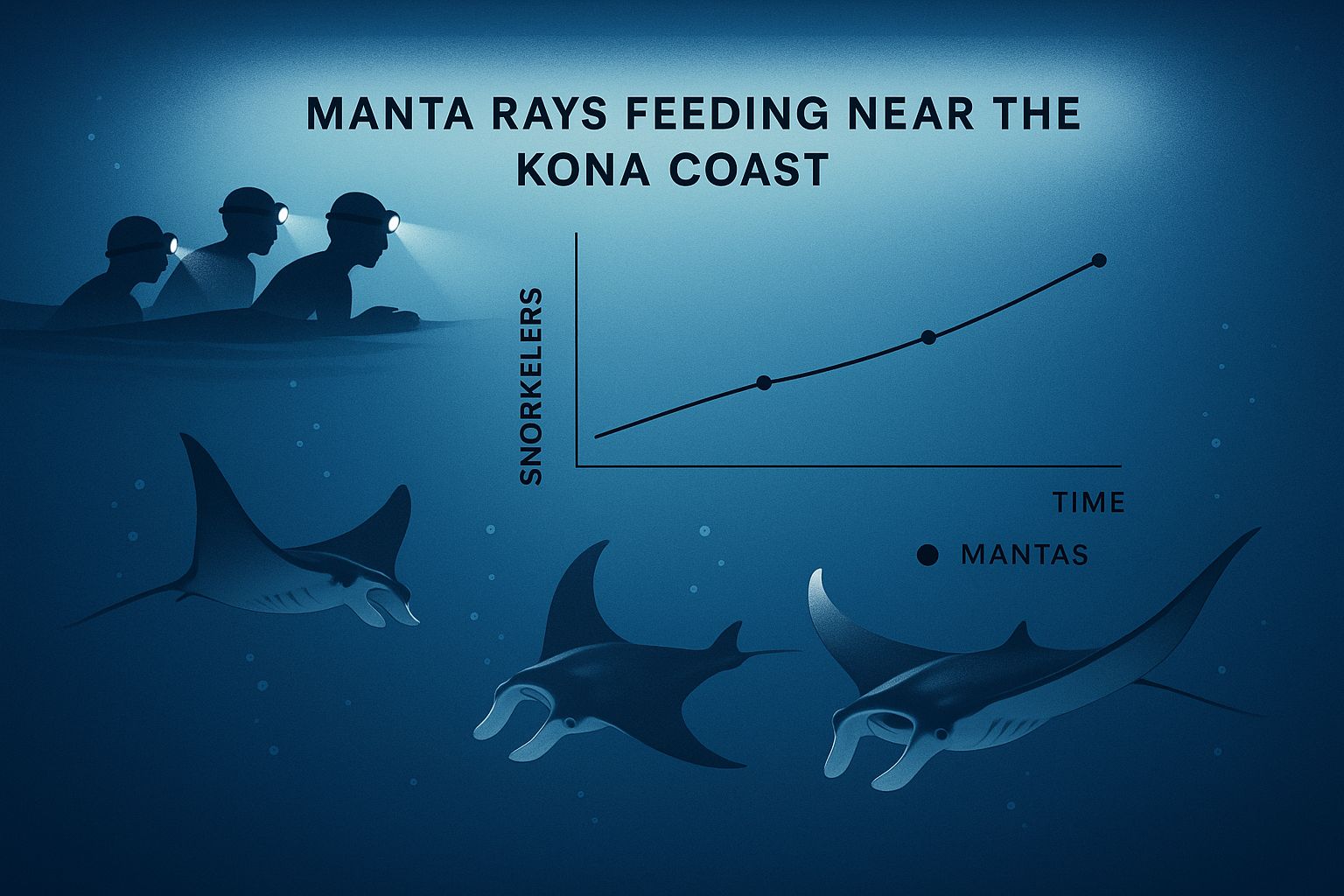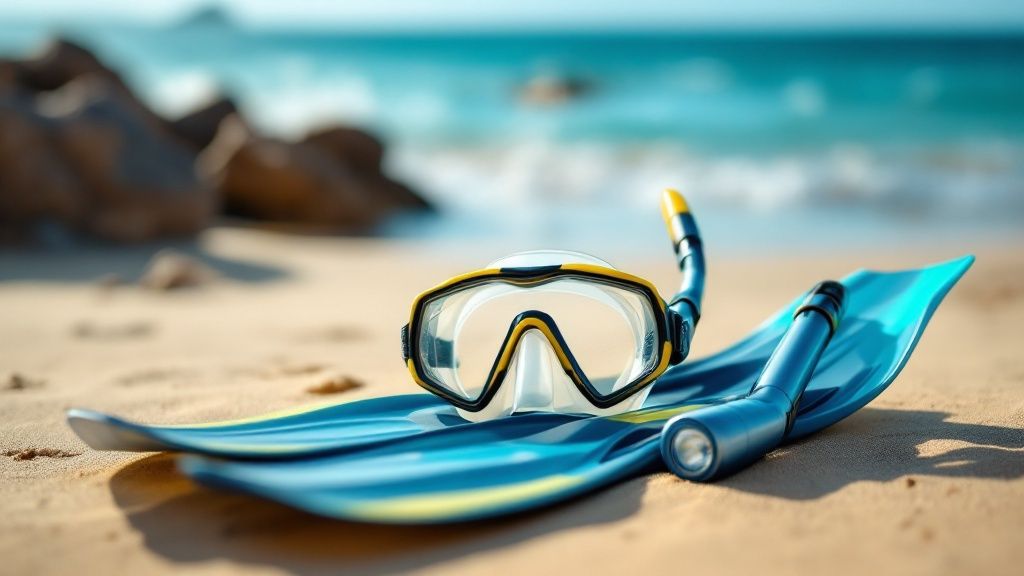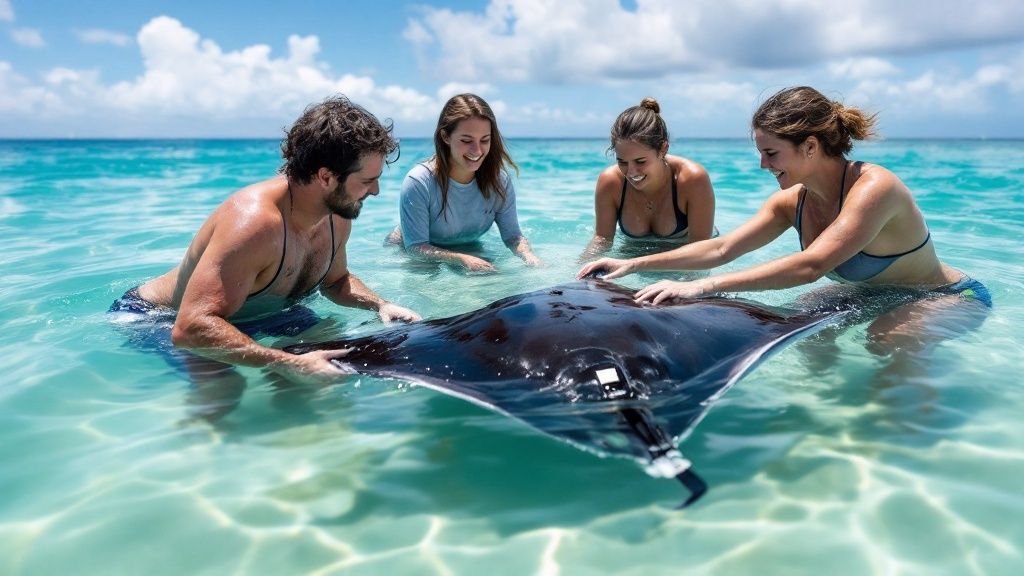Manta Ray Snorkel Kona | Unforgettable Underwater Adventure
- Byron
- May 2
- 10 min read
The Magic of Manta Ray Encounters in Kona
Swimming with manta rays is often described as a truly magical experience. Kona, Hawaii, offers one of the most reliable locations to witness these gentle giants. The convergence of several natural factors creates the perfect environment, captivating both visitors and residents for decades. This unique ecosystem has made Kona a world-renowned hotspot for manta ray encounters.
The Kona Coast: A Manta Ray Paradise
The consistent presence of manta rays in Kona is largely due to the abundance of plankton, their primary food source. Kona's nutrient-rich currents sustain plankton blooms, drawing these filter feeders nightly. These microscopic organisms, drifting in the current, provide a constant feast. This reliable food source allows the majestic mantas to thrive and provides consistent opportunities for snorkelers to observe their feeding behaviors.
This natural phenomenon is further enhanced by the lighting techniques used by tour operators. These lights attract even more plankton, creating a "buffet" that brings the mantas closer to the surface. This allows for incredible up-close views as they perform their graceful underwater ballet. To truly understand the magic, explore a comprehensive guide to Manta Ray Snorkel Kona Hawaii.
Sightings and Tracking: A Legacy of Manta Encounters
The success rate for manta ray sightings in Kona is remarkably high, typically between 80-90% year-round. With approximately 80,000 participants annually, manta ray snorkel experiences have become a cornerstone of Kona's ecotourism. Popular sites like 'Manta Village' and 'Manta Heaven' utilize plankton-attracting lights. Researchers and tour operators have tracked individual rays at these locations since at least 2013.
Historical records, detailed in PDF reports, show frequent appearances of individual mantas like 'Lefty' and 'Big Bertha'. Monthly totals from 2013 ranged from 50-150 sightings per dive location. These consistent numbers are thanks to Kona's nutrient-rich currents, which sustain the plankton blooms that attract the mantas every night. Find more detailed statistics on manta ray sightings.
Dedicated researchers and tour operators have been tracking individual mantas for years, identifying them by their unique belly patterns, much like fingerprints. Some, like "Big Bertha," have been returning to the same feeding grounds for decades. This long-term monitoring helps scientists understand manta ray behavior, population dynamics, and ecosystem health. The data gathered helps ensure the continued success of these incredible encounters for future generations.
Prime Locations for Unforgettable Manta Encounters
Kona, Hawaii, is a haven for manta ray enthusiasts, offering several exceptional locations known for consistent sightings. These sites, shaped by unique underwater topography and ocean currents, transform into magical feeding grounds as the sun dips below the horizon. Choosing the right spot can significantly enhance your manta ray snorkel Kona experience.
Manta Village: The Underwater Arena
Keauhou Bay, affectionately called Manta Village, is arguably Kona's most famous manta ray snorkel spot. This sheltered bay boasts calm, clear waters, perfect for both new and seasoned snorkelers. The relatively shallow depth and sandy bottom create a natural "underwater amphitheater," offering incredible visibility of the mantas as they perform their graceful feeding rituals.
Manta Heaven: A Deeper Dive
For a slightly different adventure, Garden Eel Cove, often referred to as Manta Heaven, presents a more adventurous setting. Just a short boat ride north of Keauhou Bay, this site has deeper waters and a slightly stronger current. The increased depth often attracts larger groups of mantas, making for a truly captivating spectacle.
Hidden Gems: Intimate Encounters
While Manta Village and Manta Heaven are popular choices, Kona has other lesser-known locations offering a more intimate manta ray experience. These hidden gems often attract smaller crowds, giving those in the know a chance to witness these gentle giants in a more private setting. This personalized interaction with wildlife adds another dimension to the already mesmerizing manta ray snorkel Kona adventure. Learn more with our sitemap of informative articles.
Comparing Kona's Manta Ray Hotspots
To help you choose the perfect spot, the following table compares key features of the main manta ray viewing locations:
As the table shows, Manta Village offers a shallower experience with fewer mantas but higher visitor traffic. Manta Heaven allows you to see more mantas in deeper water, while the lesser-known sites provide a more secluded encounter. Choosing a location aligned with your experience level and desired interaction is key.
The following data chart visualizes manta ray population data and sighting rates in Kona.

The chart reveals impressive encounter rates, highlighting the health and longevity of the Kona manta ray population.
In 2013, researchers documented up to 20 individual rays per month at key sites, with annual totals exceeding 200 unique individuals. This careful tracking, maintained by tour operators and researchers, demonstrates the impressive longevity of Kona's manta population. "Big Bertha," a ray first identified in the 1990s, is still regularly sighted. More recent data (as of 2024) estimates 250+ mantas in local databases, contributing to the 85-90% encounter rates reported by operators. Learn more about Kona manta ray sightings.
Your Nighttime Adventure: What Really Happens
Embark on a Kona manta ray snorkel adventure unlike any other. From the initial shoreside preparations to the breathtaking moment the mantas appear, every step is thoughtfully planned to create an unforgettable experience. This section guides you through a typical nighttime manta ray snorkel, giving you a glimpse of what awaits.
Preparing for the Plunge
Your adventure begins with a thorough safety briefing. Experienced guides provide detailed instructions, ensuring you feel comfortable and ready for the unique experience of night snorkeling. You'll learn specific techniques for entering the water and how to respectfully interact with the mantas. Next, you'll be fitted with snorkeling gear, including a wetsuit or flotation device, ensuring both comfort and safety in the water.
The Lighting Technique: Creating a Manta Ray Buffet
The secret to attracting these magnificent creatures lies in a clever lighting system. Special lights submerged beneath the surface attract plankton, creating a "buffet" that draws the manta rays closer. This technique has enhanced manta ray encounters, providing exceptional viewing opportunities. You'll have the chance to witness these gentle giants feeding just inches away.
The Dance of the Manta Rays
As the plankton gathers, so do the manta rays. These majestic creatures, some with wingspans reaching 12 feet or more, glide gracefully through the illuminated water. They execute mesmerizing feeding loops, their movements both powerful and elegant. Imagine the surreal sensation of a massive manta ray gracefully looping just beneath you – a truly unforgettable spectacle.

Addressing Concerns About Night Snorkeling
Night snorkeling can understandably cause some apprehension. However, the gentle currents at most manta ray sites, combined with the presence of experienced guides and the bright lights, ease many concerns. The guides offer practical advice for staying comfortable in darker waters. You might be interested in: How to master your fears related to open water. The focus shifts quickly from any initial anxieties to pure awe as the manta rays arrive. While Kona offers unique manta ray encounters, for snorkeling closer to the Florida Keys, consider options like: Marathon Key snorkeling.
The Economic and Ecological Impact
The manta ray snorkel industry in Kona isn't just about unforgettable experiences; it's a significant contributor to the local economy and a model for sustainable ecotourism. With approximately 80,000 annual participants, these tours generate over $10 million in annual gross bookings. This revenue supports local businesses and reinforces the importance of manta ray conservation. This sustainable model is built on strict conservation protocols, such as minimal-contact guidelines. The consistent sighting rates we see today (around 80-90%) are largely due to the introduction of modern light arrays around 2012, which boosted plankton density by an astounding 300-500%. Explore this topic further here. Photo identification programs track population health metrics, further contributing to our understanding and protection of these magnificent creatures.
Selecting Your Perfect Manta Ray Experience
With so many manta ray tours available in Kona, choosing the right one can feel a bit overwhelming. Understanding what makes each tour unique is key to transforming a good experience into a truly extraordinary one. This section offers some helpful advice to guide you through the options and help you select the perfect manta ray snorkel Kona adventure.
Key Factors to Consider
When choosing a tour, consider these important factors:
Group Size: Smaller groups offer a more intimate and personalized experience. A group of 10-12 people, for instance, allows for closer observation of the mantas and more interaction with your guide.
Boat Design: Think about the boat's size and layout. Some boats have expansive viewing platforms, while others offer easier water entry for those with limited mobility.
Guide Expertise: Guides with extensive experience offer invaluable insights into manta ray behavior, enriching your understanding of these magnificent creatures. They can also point out subtle cues that most visitors might miss.
Conservation Focus: Opt for operators committed to sustainable practices and manta ray conservation. This ensures your experience contributes to the long-term health of the manta ray population.
Decoding Value and Policies
Beyond the basics, savvy travelers also consider these additional points:
Value vs. Price: While price is certainly a factor, the cheapest tour isn't always the best value. Consider what's included, such as equipment rental, refreshments, and the guide's level of experience.
Cancellation Policies: Review the cancellation policy carefully, especially if you're traveling during periods of unpredictable weather. Look for operators offering flexible rescheduling options.
Special Accommodations: Some operators offer special accommodations for families with young children, photography enthusiasts, or those with accessibility needs. It's always a good idea to inquire about specific needs before booking your tour.
Choosing the Right Fit
Finding the perfect manta ray snorkel Kona experience is all about matching your personal needs and preferences with the right tour operator. The table below provides a helpful comparison of key features offered by different operators. You might also be interested in: Our site's pages sitemap for more information.
To help you make the best choice, we've compiled a comparison of several popular tour operators. The table below highlights key differences and similarities to make your decision easier.
Manta Ray Snorkel Tour Comparison: Detailed comparison of popular manta ray snorkel tour operators in Kona with key features and pricing
As you can see, each operator offers a unique combination of features and price points. Consider what's most important to you – group size, included amenities, or conservation efforts – to select the best fit.
Insider Tips for Extraordinary Manta Encounters
Transform your manta ray snorkel Kona adventure from memorable to truly magical with these insider tips from experienced ocean enthusiasts.
Timing Is Everything: Moon Phases and Seasonal Subtleties
While manta rays grace Kona's waters year-round, understanding moon phases and seasonal patterns enhances your viewing experience. A new moon creates optimal darkness, maximizing the plankton-attracting lights and drawing mantas closer to the surface. The summer months (June-August) offer calmer waters and better visibility. However, these are peak tourist times, so book your Manta Ray Night Snorkel Kona tour in advance.
Mastering Underwater Photography Without Fancy Gear
Capturing stunning underwater photos of these graceful creatures doesn't demand expensive equipment. A basic waterproof camera or GoPro can produce incredible results. Increase the ISO for low-light conditions, and get close (respectfully) to minimize the water between your lens and the mantas. Secure your camera to a float or wrist strap.
Positioning for Perfect Encounters
Your position in the water significantly impacts your manta ray viewing. Most operators use a stationary light board to attract plankton. Position yourself up-current from the light board, allowing the mantas to swim towards you as they feed. This increases your chances of a face-to-face encounter and lets you observe their natural feeding behaviors undisturbed.
Pre-Trip Preparations for a Smooth Experience
Simple pre-trip preparations can prevent common discomforts and maximize your manta ray snorkel Kona enjoyment. If prone to seasickness, take motion sickness medication beforehand. Prevent mask fogging by applying a defogging solution or toothpaste to the inside of your mask lens. For more tips on preparing for water activities, check out this helpful article.
Mindfulness and Observation: Deeper Connections
Beyond the practicalities, mindfulness enriches your manta ray encounter. Deep breaths and a relaxed body posture alleviate anxiety in darker waters, allowing you to fully appreciate the magic. Sharpen your observation skills, watching for subtle manta behaviors like barrel rolls and backflips, indicating playful interactions or courtship rituals. By staying present and attentive, you'll develop a deeper understanding of these magnificent creatures and their underwater world.
The Secret Lives of Kona's Gentle Giants

Beyond the nightly feeding spectacle, Kona's manta rays possess a captivating complexity. Understanding their behaviors and the environmental challenges they face elevates a simple snorkel trip into a truly meaningful encounter. Let's dive deeper into the world of these gentle giants.
Manta Ray Intelligence and Social Dynamics
Manta rays are more than just graceful filter feeders. They are surprisingly intelligent, exhibiting complex social lives. Studies have shown they possess problem-solving abilities and engage in intricate social interactions.
Their communication ranges from subtle body language shifts to elaborate courtship displays. This reveals a depth of intelligence that fascinates both researchers and snorkelers.
Unique Identifiers: Tracking Individual Histories
Each manta ray has a unique belly pattern, much like a fingerprint. This allows researchers to identify and track individuals over decades, gathering vital data about their life histories, migration patterns, and population dynamics.
Role in the Ecosystem and Global Threats
Manta rays are crucial to the Hawaiian marine ecosystem. As filter feeders, they help regulate plankton populations. Their presence also attracts other marine life, enriching the area's biodiversity.
However, these gentle giants face serious threats. Fishing pressure and changing ocean conditions, including increasing plastic pollution, endanger their populations.
Kona's Sustainable Tourism Model: A Global Example
Kona is a pioneer in sustainable manta ray tourism. This model prioritizes both the guest experience and the manta rays' well-being. Strict guidelines minimize disturbances, ensuring natural behaviors remain unaffected.
This approach has created a positive cycle: tourism revenue supports conservation, a successful model now replicated globally. For more information, explore our site's other helpful pages.
The Future of Manta Rays and Tourism
Kona's success demonstrates how economic value and conservation can work together. By supporting responsible operators, visitors directly contribute to protecting these magnificent creatures and their habitat. This ensures future generations can experience the magic of a Kona manta ray snorkel.
Comments